This project is made possible through the partnership of WATER CHARITY and the NATIONAL PEACE CORPS ASSOCIATION. ![]()
This project has been completed. Please scroll down the page to read about the conclusion.
Location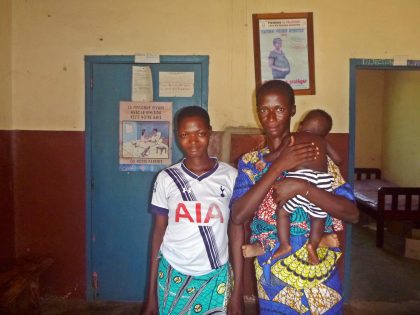
Solao, Centrale Region, Togo, West Africa
Community Description
The community of Solao (meaning “fox” in Kabyé for their abundance when the first inhabitants hunted in the area and when the landscape was still forested) was formally established in 1962 by the Kabyé people in search of farmland. Solao, located roughly 40 kilometers south of Sokodé, the capital of the Centrale Region, is another critical need clinic as identified by both the Ministry of Health and the Department of Hydraulics regional directors. Situated near Taworeda, another clinic borehole water system funded by Water Charity, Solao numbers approximately 1,300 inhabitants with an additional thousand inhabitants using the health clinic from the surrounding communities.
Today Solao is a community comprised of farmers of mixed religious affiliations and ethnicities: Muslim, Christian and animists (there is no formal nomenclature for the latter who are known locally as “les féticheurs”), and other ethnicities including Kotikoli, Losso, and Lamba, respectively. While the inhabitants are subsistence-level farmers, the area yields for most crops (maize and yams in particular) for most years exceed the annual household needs, with excess sold in the local markets or to buyers from the larger urban centers. Other crops grown are soy which is transformed into what we know as “tofu”, sorghum, millet, beans, and rice.
While food insecurity is not an issue, water scarcity is a major problem as in most of the region. There are few year-round producing wells (two to be exact that are functioning) as most of the community water sources are shallow, open wells of mostly unpotable water and intersecting the shallow intermittent subsurface zone. Once the dry season is in full swing, generally around January, most of these community and household wells run dry.
The health clinic was built in 2002 with substantial funds from a Japanese NGO that anticipated a “modern” clinic. What was (poorly) built was a small 6-room cement structure with no water source nor power (hence another “birth by flashlight” center for nighttime births) though equipped with some indoor plumbing. At the time of construction, the center was not under the supervision of the Ministry of Health and only later in 2008 did the regional Ministry of Health assume control. Plan International installed a borehole well equipped with a hand pump sometime later which the Department of Hydraulics overhauled in 2017. The clinic is staffed by a midwife and a “pharmacist”, both from and paid by the community, and ahead nurse, paid by the Ministry of Health. The clinic sees an average of 130 patients a month and around 8 births during this time. Malaria heads the list of most common ailments seen at the clinic, particularly with young children and toddlers; followed by parasitic diseases, various other infections and respiratory problems particularly during the dry season when both ash from burning fields (a common post-harvest practice) and general poorer quality air conditions (from the seasonal Harmattan weather pattern – a very dry and hot continental wind carrying high altitude dust particles south from the Sahara Desert).
Problem Addressed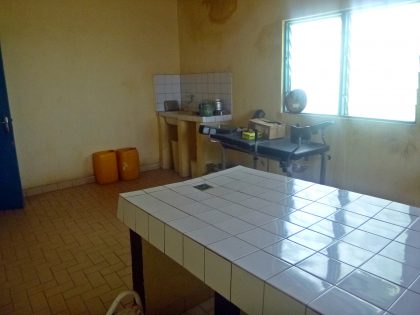
While the health clinic at Solao has a borehole well equipped with a hand pump, the same hygiene problems are present, albeit to a lesser extent than those clinics with water from open wells; problems associated with hand delivery of water from what is also a community well into the clinic and stored in containers throughout the center. The lack of running water inside the clinic is particularly onerous for the midwives, the patients and the relatives of the patients as the latter are required to fetch water for pre-and post-birth use and clean up. There are no floor drains, the plumbing is clogged, and the discharge vent on the maternity table is also nonfunctioning. At present, the midwives have no means of dispensing of waste from the birth process except by hand carrying the waste in a basin and dumping the waste in the latrines. No floor or maternity table drains are functioning nor is water readily available for cleaning. The water quality of the borehole is unknown at this time.
Project Description
Under the guidance of the Department of Hydraulics and Sanitation’s regional office in Sokodé and with support from the Ministry of Health regional director who identified clinics with the most critical need, this project will “rehabilitate” an existing borehole well located at the Solao health clinic. This project proposes to drill a 60- to 100-meter borehole well at the clinic, equipped with the following:
• An electric submersible pump
• a 4.5-meter high cement block water tower
• a 2 meter3 polyethylene tank
• piping to the main intake valve at the clinic
The submersible pump will be run using a gas-powered generator as there is currently no electric power in the community. The local drilling company selected, Plomberie Génerale de Réalisation de Forage, in operation since 1998 and based in Tchamba, has extensive experience drilling deep borehole wells throughout Togo and regionally in Burkina Faso, Benin, and Nigeria.
Project Impact
2,300 people will benefit from the project.
Proj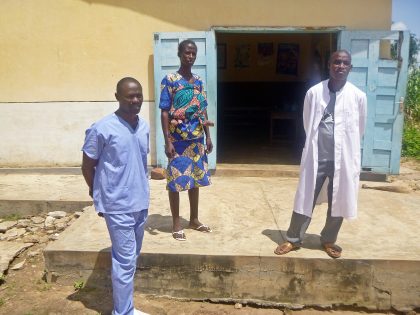 ect Administration
ect Administration
This project will be managed by Anne Jeton, hydrologist and Returned Peace Corps Volunteer (RPCV), Burkina Faso (’82-’85) and Returned Peace Corps Response Volunteer (RPCRV), Togo (’16 -’17). Anne was sent to Togo on behalf of Water Charity to develop and administer new projects, and to coordinate with Peace Corps.
Monitoring and Maintenance
Along with staff from the Department of Hydraulics and Sanitation who will monitor the well “indefinitely” (the well data becomes part of the official borehole well database, and as such is included in periodic field monitoring by technicians based in each Prefecture), the contract for well drilling states a one-year guarantee provided by the drilling company. Problems with pump and borehole functioning are typically resolved in the first month of use.
Proper screening of the borehole and submersible pump placement relative to the static water table often mitigate the most common problems. However, any mechanical problems surfacing in the first year will be the responsibility of the drilling company.
The clinic staff will be responsible for maintaining a well repair account which will be funded from the sale of medicines. The clinic will decide a nominal fee for water use should the water account be insufficient, or the community will be asked to contribute directly to the costs.
Project Funding
This project has been funded by an anonymous donor.
Conclusion of Solao Clinic Borehole Water System Project – Togo
This project was managed by Anne Jeton, hydrologist and Returned Peace Corps Volunteer (RPCV), Burkina Faso (’82-’85) and Returned Peace Corps Response Volunteer (RPCRV), Togo (’16 -’17).
Project Name: Solao Health Clinic Borehole Well Water System, Centrale Region, Togo
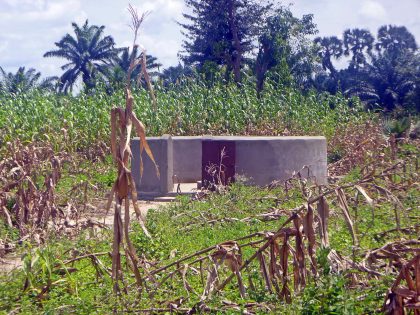 The purpose of the borehole water system project at the Solao health clinic was to address a lack of both potable and year-round water, either the absence of or nonfunctioning indoor plumbing and the lack of a hygienic disposal of afterbirth blood and tissue.
The purpose of the borehole water system project at the Solao health clinic was to address a lack of both potable and year-round water, either the absence of or nonfunctioning indoor plumbing and the lack of a hygienic disposal of afterbirth blood and tissue.
The maternity delivery room was equipped with a sink, faucet and running, potable water, and through additional outside funding; a floor drain and a discharge chamber, both plumbed to a dedicated subsurface cement-lined and ventilated septic tank. Delivery room waste (blood and tissue) can now be dispensed with directly in the maternity room in a safe and hygienic manner, rather than hand-carried by the midwives to an outdoor pit or in many cases poured into the latrines.
The scope of the project entailed “rehabilitating” the existing borehole well (flushing out accumulated sediment and organic matter inside the well casing), replacing the existing hand-pump with a submersible electric pump, building a water tower with community access points, and establishing a gravity-fed system to provide for indoor plumbing. A “pump test” was run to determine the well’s productivity and in turn the hydraulic properties of the aquifer. The pump was run for several hours at a rate like actual use and the declining water table (drawdown) was measured at regular intervals. The Solao borehole was drilled to a depth of 52 meters and has a yield of 2,900 liters/hour which is more than adequate to supply both the clinic’s needs and those of the surrounding households. The pump test also indicated a rapid refilling of the borehole, implying that even when running at the maximum yield rate, the well should recover quickly and not result in significant lag times. Simply put, the hydraulic conditions of the well are favorable to ensure a sustainable water supply for many years to come (assuming the system is well maintained).
Water samples from both the borehole well and the original clinic well were taken and sent to the Regional laboratory in Sokodé, the regional capital, for a complete microbial and inorganic compound analysis. The results of this analysis indicate zero presence of any of the disease-causing bacteria tested (E Coli, Salmonella, Fecal Streptococci, Enterococci and a general category of thermotolerant Coliforms) in the new borehole well.
Numerous visits were made during the well installation by the Water Charity Coordinator and the government hydrologist to oversee construction and to ensure the clinic and community leaders understood the responsibilities associated with maintaining and ensuring sustainable water supply. A final visit by the Regional Director of hydraulics insured the borehole well and the associated delivery system met all the driller’s contract requirements and functionality.
An official technical opening concluded the project with a presentation by the driller on the boreh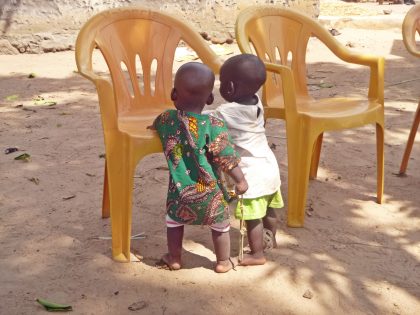 ole well components, brief discourses by the Department of Hydraulics Regional Director, village leaders, the Water Charity coordinator, and a representative from the regional ministry of health. As the representative for Water Charity and its donor(s), the Coordinator reinforced previously discussed themes of maintenance and upkeep through the active participation of a community water committee and a clinic repair account, to manage public access to the well in a non-disruptive manner to the clinic staff and patients, and most importantly to take responsible ownership of this valuable resource.
ole well components, brief discourses by the Department of Hydraulics Regional Director, village leaders, the Water Charity coordinator, and a representative from the regional ministry of health. As the representative for Water Charity and its donor(s), the Coordinator reinforced previously discussed themes of maintenance and upkeep through the active participation of a community water committee and a clinic repair account, to manage public access to the well in a non-disruptive manner to the clinic staff and patients, and most importantly to take responsible ownership of this valuable resource.
CONCLUSION AND IMPACT:
The Solao clinic serves a population of approximately 2,300 people, including the neighboring villages, who will directly benefit from a more hygienic health clinic. While clearly not all 2,300 people living in Solao will be accessing the well water for personal consumption, the community development liaison estimated perhaps as many as 1,000 inhabitants may utilize the community access point. The clinic anticipates seeing a rise in births as there is now running water and female relatives are no longer obliged to fetch water for the patient, in addition to an overall improvement in hygiene. The clinic staff will use access to potable water to encourage better overall hygiene, as most of the disease-causing bacteria in the community water sources are due to fecal transmission by both animals and humans. The clinic staff, particularly the midwives and their assistants (which often include female relatives) will be better protected against blood-borne diseases as afterbirth material (blood and tissue) will be dispensed in a rapid and efficient manner, significantly reducing exposure.
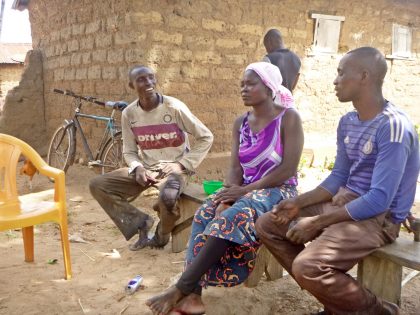 The Regional Director of the Department of Hydraulics stated in his technical report the Solao health clinic borehole well water system has fully succeeded in meeting both the local and national objectives for potable water. The Department of Hydraulics, the Ministry of Health and staff at each rural health clinic served by this project have repeatedly been astounded at the expediency with which funding was made available thus allowing work to begin within weeks of submitting the project request. Thank you, donors and Water Charity! The efficiency of work that followed was due in large part to the incredible efficiency, planning, and hard work by the local drilling company’s crew. The Regional Director and the hydrogeologist at the Department of Hydraulics and Water in Sokodé also contributed their time, vehicle and expertise to ensure all technical aspects of the project conformed to modern standards and have assured their continued presence as the borehole wells are now part of the national water database and monitoring program. Having the government of Togo involved from the beginning in this suite of health clinic projects, from the selection of health centers to technical oversight and continued monitoring by the Ministry of Water officials, has confirmed the importance of not doing community projects as isolated NGOs. This last point is critical to continued success as most water projects in Togo are implemented without government oversight, leading to a myriad of problems none the least being poor technical implementation and little to no continued oversight.
The Regional Director of the Department of Hydraulics stated in his technical report the Solao health clinic borehole well water system has fully succeeded in meeting both the local and national objectives for potable water. The Department of Hydraulics, the Ministry of Health and staff at each rural health clinic served by this project have repeatedly been astounded at the expediency with which funding was made available thus allowing work to begin within weeks of submitting the project request. Thank you, donors and Water Charity! The efficiency of work that followed was due in large part to the incredible efficiency, planning, and hard work by the local drilling company’s crew. The Regional Director and the hydrogeologist at the Department of Hydraulics and Water in Sokodé also contributed their time, vehicle and expertise to ensure all technical aspects of the project conformed to modern standards and have assured their continued presence as the borehole wells are now part of the national water database and monitoring program. Having the government of Togo involved from the beginning in this suite of health clinic projects, from the selection of health centers to technical oversight and continued monitoring by the Ministry of Water officials, has confirmed the importance of not doing community projects as isolated NGOs. This last point is critical to continued success as most water projects in Togo are implemented without government oversight, leading to a myriad of problems none the least being poor technical implementation and little to no continued oversight.
The Solao project was implemented in concert with five other health center water system projects, scattered over two districts – all of which were completed on schedule. The community of Solao offers its sincere thanks and gratitude to the donor(s) for this valuable water resource. As they say here “l’eau est la vie”. Water is life, and the cleaner the water the longer and more satisfying life will be! Un grand merci!